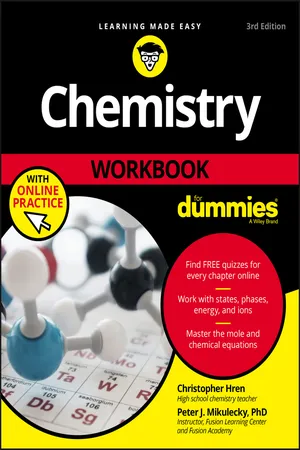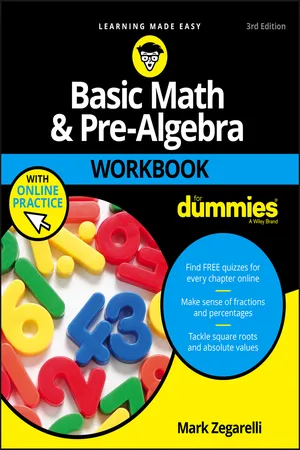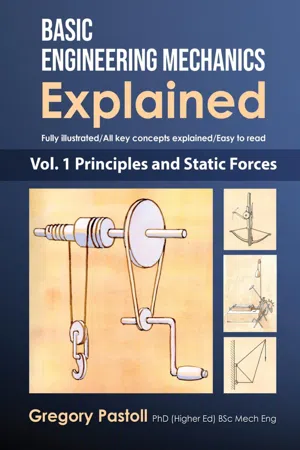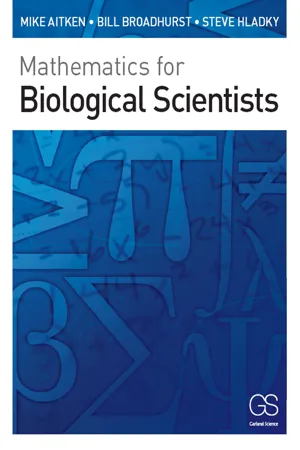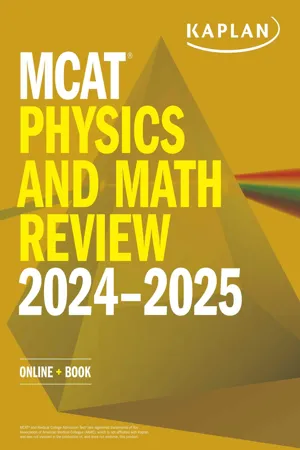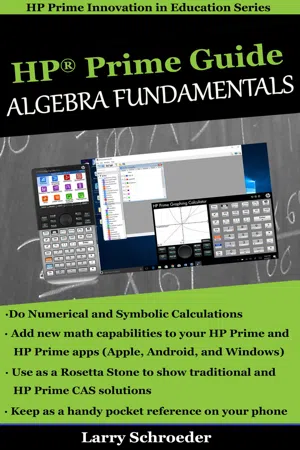Mathematics
Scientific Notation
Scientific notation is a way of expressing very large or very small numbers in a more concise and manageable form. It involves writing a number as a product of a decimal and a power of 10. This notation is useful in scientific and mathematical calculations, as it simplifies the representation of extremely large or small values.
Written by Perlego with AI-assistance
Related key terms
Related key terms
1 of 4
Related key terms
1 of 3
10 Key excerpts on "Scientific Notation"
- Chris Hren, Peter J. Mikulecky(Authors)
- 2017(Publication Date)
- For Dummies(Publisher)
Numbers describing the distance between two atoms joined by a bond, for example, run in the ten-billionths of a meter. Numbers describing how many water molecules populate a drop of water run into the trillions of trillions. To make working with such extreme numbers easier, chemists turn to Scientific Notation, which is a special kind of exponential notation. Exponential notation simply means writing a number in a way that includes exponents. In Scientific Notation, every number is written as the product of two numbers, a coefficient and a power of 10. In plain old exponential notation, a coefficient can be any value of a number multiplied by a power with a base of 10 (such as 10 4). But scientists have rules for coefficients in Scientific Notation. In Scientific Notation, the coefficient is always at least 1 and always less than 10. For example, the coefficient could be 7, 3.48, or 6.0001. To convert a very large or very small number to Scientific Notation, move the decimal point so it falls between the first and second digits. Count how many places you moved the decimal point to the right or left, and that’s the power of 10. If you moved the decimal point to the left, the exponent on the 10 is positive; to the right, it’s negative- eBook - ePub
Science and Technical Writing
A Manual of Style
- Philip Rubens(Author)
- 2002(Publication Date)
- Routledge(Publisher)
- Place a decimal point to the right of the first nonzero digit in the number,
- Delete all nonsignificant zeros (see 7.38 ), and
- Multiply the resulting number by the power of ten required to make the product equal to the original number.
Thus:247,000,000 becomes 2.47 108 in Scientific Notation, and0.000014647 becomes 1.4647 10–5 .7.29 The exponent (the power of ten) can be negative or positive depending on whether the number being represented is smaller or larger than 1 (the number 1 is equal to ten to the zero power). A factor of 100 is customarily omitted. Various examples of small or large numbers and their equivalents in Scientific Notation include 27.5 2.75 × 10 (not 2.75 × 101 ) 1.375 1.375 (not 1.375 × 100 ) 37,040,000 3.704 × 107 (assuming the trailing zeros are not significant) 2,000,000 2 × 106 (not 2.0 × 106 )(assuming the trailing zeros are not significant) 0.000715 7.15 × 10-4 0.09004 9.004 × 10-2 0.000000000145 1.45 × 10-10 10.07 1.007 × 10 7.30 The factor preceding the power of ten, the “mantissa,” is normally between one and ten, as in the preceding examples. However, there is an alternative convention of representing numbers in Scientific Notation so that the power of ten is a multiple of three. This practice fits the structure of the prefixes used in the International System of Units (see 7.41 ). When this convention is used, the mantissa will be between 1 and 999:149.598 × 106 km (not 1.495 98 108 - Mark Zegarelli(Author)
- 2017(Publication Date)
- For Dummies(Publisher)
In this chapter, you discover Scientific Notation as a handy alternative way of writing very large numbers and very small decimals. Not surprisingly, Scientific Notation is most commonly used in the sciences, where big numbers and precise decimals show up all the time. On the Count of Zero: Understanding Powers of Ten As you discover in Chapter 2, raising a number to a power multiplies the number in the base (the bottom number) by itself as many times as indicated by the exponent (the top number). For example,. Powers often take a long time to calculate because the numbers grow so quickly. For example, 7 6 may look small, but it equals 117,649. But the easiest powers to calculate are powers with a base of 10 — called, naturally, the powers of ten. You can write every power of ten in two ways: Standard notation: As a number, such as 100,000,000 Exponential notation: As the number 10 raised to a power, such as 10 8 Powers of ten are easy to spot, because in standard notation, every power of ten is simply the digit 1 followed by all 0s. To raise 10 to the power of any number, just write a 1 with that number of 0s after it. For example, 1 with no 0s 1 with one 0 1 with two 0s 1 with three 0s To switch from standard to exponential notation, you simply count the zeros and use that as the exponent on the number 10. You can also raise 10 to the power of a negative number. The result of this operation is always a decimal, with the 0s coming before the 1. For example, 1 with one 0 1 with two 0s 1 with three 0s 1 with four 0s When expressing a negative power of ten in standard form, always count the leading 0 — that is, the 0 to the left of the decimal point. For example, has three 0s, counting the leading 0. Q. Write 10 6 in standard notation. A. 1,000,000. The exponent is 6, so the standard notation is a 1 with six 0s after it. Q. Write 100,000 in exponential notation. A- eBook - ePub
- Mark Zegarelli(Author)
- 2016(Publication Date)
- For Dummies(Publisher)
Part 4Picturing and Measuring — Graphs, Measures, Stats, and Sets
IN THIS PART … Represent very large and very small numbers with Scientific Notation. Weigh and measure with both the English and metric systems. Understand basic geometry, including points, lines, and angles, plus basic shapes and solids.Present math info visually, using bar graphs, pie charts, line graphs, and the xy -graph.Solve word problems involving measurement and geometry. Answer real-world questions with statistics and probability. Get familiar with some basic set theory, including union and intersection.Passage contains an image Chapter 14
A Perfect Ten: Condensing Numbers with Scientific Notation
IN THIS CHAPTER Knowing how to express powers of ten in exponential form Appreciating how and why Scientific Notation works Understanding order of magnitude Multiplying numbers in Scientific NotationScientists often work with very small or very large measurements — the distance to the next galaxy, the size of an atom, the mass of the Earth, or the number of bacteria cells growing in last week’s leftover Chinese takeout. To save on time and space — and to make calculations easier — people developed a sort of shorthand called Scientific Notation.Scientific Notation uses a sequence of numbers known as the powers of ten, which I introduce in Chapter 2 :1 10 100 1,000 10,000 100,000 1,000,000 10,000,000 …Each number in the sequence is 10 times more than the preceding number.Powers of ten are easy to work with, especially when you’re multiplying and dividing, because you can just add or drop zeros or move the decimal point. They’re also easy to represent in exponential form (as I show you in Chapter 4 ):100101102103104105106107 …Scientific Notation is a handy system for writing very large and very small numbers without writing a bunch of 0s. It uses both decimals and exponents (so if you need a little brushing up on decimals, flip to Chapter 11 - eBook - ePub
Basic Engineering Mechanics Explained, Volume 1
Principles and Static Forces
- Gregory Pastoll, Gregory Pastoll(Authors)
- 2019(Publication Date)
- Gregory Pastoll(Publisher)
Chapter 3 Working with numbers in engineering• Engineering notation, as opposed to scientific or ordinary notation• The number of significant figures in a value• Required format of answers for engineering purposes• Loss of accuracy when rounding off numbers during a calculation• The units that apply to mechanical quantities in the S.I. system• The difference between precision and accuracy• The limitations of precision in a primarily practical science• Converting the units of quantities, e.g. miles per hour to metres per second• Units preferred by engineersAn engineering student needs to know how to write and interpret numbers for the purposes of engineering. At some stage in your career, you will be writing lab and other types of investigative reports, performing calculations, and showing the results of your calculations. It is essential to get to know the conventions.Engineering notation, as opposed to scientific or ordinary notation Any given number can be expressed in three ways: ordinary arithmetic notation, Scientific Notation, and engineering notation.Ordinary arithmetic notation is what comes up on your calculator readout when you key in a sequence of digits. For example: 86.5 or 374.29 or 128502.972Scientific Notation is a way of writing a number in terms of multiples of powers of ten. For example: 1.284 × 104 or 4.932 × 1017 or 7.996 × 10−6 . In Scientific Notation, the aim is to express the number as compactly as possible. Only one digit is allowed in front of the decimal point, and any multiple of powers of 10 can be used.Often, however, numbers expressed in Scientific Notation, though mathematically valid, are not conveniently practical for engineers to work with. For this reason, engineering notation was developed.Consider the number, in ordinary notation: 154 300. A scientist would write it as 1.543 x 105, whereas an engineer would write it as 154.3 x 103. If both are mathematically correct, what’s the difference, and why is there a difference? - eBook - ePub
- Mike Aitken, Bill Broadhurst, Stephen Hladky(Authors)
- 2009(Publication Date)
- Garland Science(Publisher)
to say, whichever way we choose to do it, we would not normally write out all the steps. To multiply or divide numbers in Scientific Notation we multiply or divide the coefficients and add or subtract the exponents, for example 3.45 × 10 3 × 2.71 × 10 − 1 = (3.45 × 10 × 10 × 10) × (2.71 ÷ 10) = 3.45 × 2.71 × 10 × 10 × 10 ÷ 10 = 9.35 × 10 × 10 = 9.35 × 10 2 or, more. concisely 3.45 × 10 3 × 2.71 × 10 − 1 = 3.45 × 2.71 × 10 (3 − 1) = 9.35 × 10 2. The 9.35 is just the product of the coefficients; the 2 in the exponent of 10 2 counts up the number of times we need to multiply by 10. There is a very similar procedure for division, for example 3.45 × 10 − 3 ÷ 2.3 × 10 1 = (3.45 / 2.3) × 10 − 3 − 1 = 1.5 × 10 − 4. If, after multiplying or dividing the coefficients and rounding the answer to the desired number of significant figures (three, say), the portion of the number to the left of the decimal point is not in the range from 1 to 10 (excluding 10 itself), then we. multiply or divide by 10 so that it is, and adjust the exponent accordingly. For example: initial answer intermediate step final form 13.3 × 10 3 (13.3 / 10) × (10 × 10 3) 1.33 × 10 4 0.678 × 10 − 5 (0.678 × 10) × (10 − 5 / 10) 6.78 × 10 − 6. 2.7 Solving equations Scientists frequently need to solve equations. In this section we shall see some methods that can be used, but first we need to define some of the language and look at the basic manipulations of expressions and equations that we need to be able to do. Some basics An equation is a statement that two expressions are equal to each other; for example, 2 + 3 = 5 or 2 x – 3 az = 2 y. An expression is a combination of symbols; for example, 2 + 3 or 2 x – 3 az. A part of an expression is called a sub-expression of that expression; for example, 2 is a sub-expression of 2 + 3 = 5 and 3 a is a sub-expression of 2 x – 3 az - No longer available |Learn more
MCAT Physics and Math Review 2024-2025
Online + Book
- (Author)
- 2023(Publication Date)
- Kaplan Test Prep(Publisher)
also know that calculators aren’t allowed, so even the most complex math still has to be solvable in a reasonable amount of time. We reconcile these two opposing concepts by using a few Test Day tricks: Scientific Notation, which can help us narrow down the exponent of our answer choice and often gives the answer directly; and judicious estimation, which will differentiate between otherwise similar answers. While significant figures won’t lead us to an answer in the way that the other MCAT skills will, it is a testable topic on the MCAT.KEY CONCEPT
It is essential to use judicious rounding and math strategies on Test Day to get through the MCAT efficiently. This is particularly true in the Chemical and Physical Foundations of Biological Systems section. Do not try to solve for an exact answer—do only as much as you need to be able to choose the right answer choice!Scientific Notation
Scientific Notation is a method of writing numbers that takes advantage of powers of ten. In Scientific Notation, a number is written with a significand and an exponent. This is much easier to conceptualize with an example. Consider the number 217. The math using this number can be somewhat cumbersome. By transforming it into Scientific Notation (2.17 × 102 ), the number becomes easier to manipulate because the power of 10 has been pulled out. In this case, 2.17 is the significand (also called the coefficient or mantissa), and the 2 in 102 is the exponent.The significand must be a number with an absolute value in the range [1,10]. This means that it is any real number between –10 and –1 (not including –10) or between 1 and 10 (not including 10). By extension, the significand cannot begin with a 0, nor can it begin with two digits before the decimal point. The exponent, on the other hand, can be any whole number—positive, negative, or 0.If at any time your calculations are not in Scientific Notation, consider adjusting them. While there is a small time investment converting to Scientific Notation, the time saved on subsequent calculations usually makes up for—and often exceeds—this time investment. This is especially true for questions in which the answers differ by powers of ten. The only exception to maintaining Scientific Notation is in the calculation of square roots, which are discussed later in this chapter. - eBook - ePub
HP Prime Guide Algebra Fundamentals
HP Prime Revealed and Extended
- Larry S Schroeder(Author)
- 2017(Publication Date)
- Larry Schroeder(Publisher)
Explanation 1.1 - Real Numbers
In this section we introduce exponential notation and look at order of operations. We then introduce the real numbers; look at subsets of the real numbers, and the real numbers on a number line.Exponential Notation
What is a billion divided by a thousand? Doing math with exponents is easier because you can subtract to do division and add to do multiplication.The zeros in a problem can be used for its significant figures in measured numbers. For the trailing zeros in a billion and a thousand to be considered significant in measured numbers, they would have to be indicated. Various methods are used to identify significant figures in a number without a decimal point containing trailing zeros. Two common methods are bar above or under the last significant zero.For multiplication or division the results number of significant figures is the least of its significant figures in the original measured numbers used in the calculation. Significant figures in arithmetic will be explained in section 1.3 discussion of Scientific Notation .Note: When we are using a measuring tool to determine a quantity we will use measured numbers. Exact numbers are another important type of number used in measurement problems. Exact numbers result from a count or are defined numbers. We will assume in our discussion, examples, and exercises unless measurement or exact numbers are involved that we are dealing with numbers in general and no reference will be made to significant figure or decimal places in our solutions.HP Prime Family Using ExponentsBegin by selecting the CAS key on the HP Prime. Key in as shown. Use the exponent key and fraction template. The fraction template is found by pressing the fraction/ square root/ absolute value key. For the last entry, press Enter to verify that there are six factors of ten in the answer of a million. If the CAS view has computations, clear the history first. To clear the history, press the Clear - eBook - ePub
Computer Architecture
Software Aspects, Coding, and Hardware
- John Y. Hsu(Author)
- 2017(Publication Date)
- CRC Press(Publisher)
i ≤ B, and B is referred to as the base, or radix. In a decimal system, the base B is 10. If a number is written as a decimal, then all the coefficients are readily visible from its notation. For example, the number 221 in decimal form has the following meaning:221 = 2 *10 2+ 2 *10 1+ 1 *10 0= 2 * 100 + 2 * 10 + 1Each digit in the number carries a weight, and the right-most digit carries a weight of one because any base to the power of zero is defined to be one. The second digit from the right carries a weight of 10, and the third digit carries a weight of 100.2.3 NUMBER SYSTEMS
To generalize the concept, any positive integer of base B may be written in a positional notation abbreviated asC jC j-1… . CIf the base B is omitted in the above notation, the default base is assumed to be 10, unless otherwise specified. A number of base 10, is said to be in decimal form. In the above notation, C0 is the least significant digit, and Cj is the leading non-zero digit. The number 221 in decimal form is different from a number 221 of base 8 or base 16 as shown below:It is important to know that the positional notation is used to evaluate a positive integer of any base, and its decimal value serves as a reference point for number conversions.221 10= 2 *10 2+ 2 *10 1+ 1 *10 0= 221221 8= 2 *8 2+ 2 *8 1+ 1 *8 0= 145221 16= 2 *16 2+ 2 *16 1+ 1 *16 0= 5452.3.1 Binary
The number system used in a computer is binary, or base two. In a binary number, each coefficient Ci in the notation carries a weight of 2i . Any piece of information, machine instruction or data, is represented by a bit string of ones and zeroes. While many different data types are used in a computer, they are all bits; only the way they are used creates the difference between them. We may use four bits to represent an unsigned integer whose value is always positive; that means the four-bit number really represents five bits with the leading bit zero hidden as a positive sign. Since the total number of combinations is 16 (24 - eBook - ePub
- Sylvia Turner, Judith McCulloch(Authors)
- 2017(Publication Date)
- Routledge(Publisher)
Consider 3 2 or 4 3. Index notation is generally introduced using geometric representations and the index number is then seen as a shorthand way of recording notation of repeated multiplication. However, it is important to be clear in explanations to children about the meaning of such numbers, i.e. that they stand for the power to which a number is multiplied or the number of times a number is multiplied by itself, i.e. 4 3 means 4 × 4 × 4 and is equal to 64. When index notation is considered with respect to the number 10, it relates to our place value system. For example, 10 0 is 1 and relates to the ones column and 10 1 is 10 and this relates to the tens column. Following this pattern, 10 2 is 100 and so on. This allows us to represent numbers that would be very cumbersome if represented in the traditional column form. Negative numbers Negative numbers are part of the set of integers. We refer to positive numbers just by the number names but negative numbers by a specific term ‘negative one’ etc. However, colloquially, these integers are often referred to as ‘minus one’ etc. The term minus, correctly, refers to the operation of subtraction. Whatever the number is called, there can be confusion associated with the dual use of the term meaning negative and subtract. Estimation Discussion of estimation in relation to near equivalence has been discussed in Chapter 1. Children must learn to estimate in number, measurement and handling data with increasing sophistication as they are introduced to a widening range of contexts. They learn to estimate a number of objects, round to the nearest 10, 100, 1 decimal place etc. and apply understanding of the real world to solving problems so that they are able to understand an equivalence between mathematical solutions and real world solutions. One of the means whereby children are able to carry out complex problems is by use of a calculator
Index pages curate the most relevant extracts from our library of academic textbooks. They’ve been created using an in-house natural language model (NLM), each adding context and meaning to key research topics.
Explore more topic indexes
Explore more topic indexes
1 of 6
Explore more topic indexes
1 of 4
